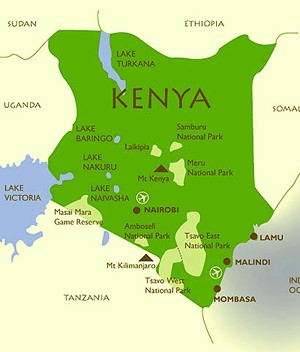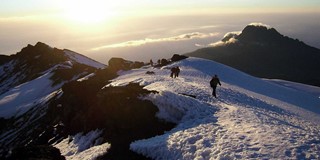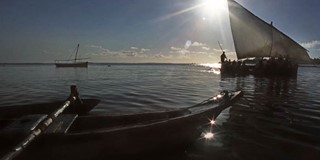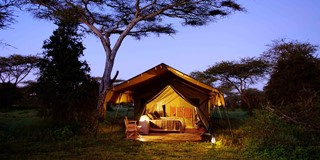
Amboseli National Park
Speak to our tour consultants for a more custom made itinerary to suit your travel needs.
Tel: +254 706 124 625

- Background Information
- Wildlife and Birds
Amboseli comes from the word Empusel, meaning “open plain” in the language of the local Maasai people. The origins of these nomadic peoples are shrouded in mystery, but it is thought that their ancestors and those of their Samburu cousins came from modern day Sudan migrating south along the Nile Valley, arriving in northern Kenya about mid-fifteenth century. Kilimanjaro dominates the area, its peaks in neighboring Tanzania. Africa’s highest mountain would have been in Kenya had it not been for Queen Victoria’s giving it as a wedding gift to the German Kaiser!
Today: This wildlife reserve on Kenya’s southern boundary provides possibly the most varied and enduring images of East Africa with its vast open plains, yellow-barked Acacia woodland, rocky lava-strewn thorn-bush country, swamps and marshes, and dry lakebed. Further west of the Reserve lies Namanga, the border town into Tanzania. Above Namanga, Oldoinyo Orok rises to over 2,760m (8,300 feet), its rocky heights still largely zoologically unexplored. The snows of Kilimanjaro, white and crystalline, form a majestic backdrop to one of Kenya's most spectacular displays of wildlife, thus creating Kenya's most sought after photographers’ paradise. Usually the whole mountain basks in the morning sun, or evening light, other times its snowcap hovers above the clouds. Sometimes it vanishes completely under a mantle of thick cloud. The heart of the park is fed by subterranean streams flowing down from Kilimanjaro’s glaciers. These create swamps, which form permanent watering places for the wildlife through times of drought. They are frequented by Elephant, Hippo and plains’ game.
During the dry seasons a curious feature is the shimmering heat above the lakebed, where false mirages of populated horizons - punctuated by real herds of Zebra and Wildebeest, hover in front of visitors. The lakebed is subject to sporadic floods and noxious salts in the gravel bed are dissolved to serve as a deadly poison for what is left of the local forest. Very few of the fine acacias, once a feature of this region, remain. Meanwhile Maasai cattle are destroying the delicate but precious grassland. To sustain this fragile environment the National Reserve requests that vehicles stick to roads and tracks. The Park's best game drives are around the swamps and there is a fine lookout on Observation Hill, which offers views over Amboseli and beyond.
A principal attraction of Amboseli is its vast herds of Elephant - renowned for having the heaviest ivory in Kenya. Lion, Elephant, Leopard, Cheetah, Buffalo and Maasai Giraffe may all be seen on a morning’s drive, as well as hosts of plains' game, including Common Zebra, Eland, Coke’s Hartebeest, White-bearded Gnu, Common Waterbuck, Thompson’s and Grant’s Gazelles and Impala. Smaller mammals include Black-faced Vervet Monkey, Yellow Baboon, Black-backed Jackals, Spotted Hyena and Bat-eared Foxes. Caracal and Serval cats are sometimes seen. Birdwatchers can spot 3 species of Sand grouse, 47 different birds of prey, the very local Taveta Golden Weaver and flocks of common but eye-catching superb starlings, amongst many other species. Birds of prey include the rare Taita Falcon and Southern Banded Harrier Eagle.
Elephant Research in Amboseli: the Amboseli Elephant Research Project in represents the longest and most detailed study of elephants in the world. The future of wildlife and National Parks in Kenya hangs in the balance, and for many people elephants, their survival or their demise, symbolize the play of opposing forces. In a nation where the needs of people come into conflict with those of elephants on a daily basis the research is used to collectively understand the challenges and the opportunities that elephants and wildlife in general represent.
The Amboseli Trust for Elephants aims to ensure the long-term conservation and welfare of Africa’s elephants in the context of human needs and pressures through scientific research, training, community outreach and public awareness. Run by veteran conservationist and fundraiser, Cynthia Moss the Trust runs a permanent research project inside the National Reserve. Lectures by Cynthia Moss’s research team can be arranged during a visit to Amboseli and give a fascinating insight into the communication, hierarchical structure and relationship with these magnificent inhabitants of Amboseli Reserve.
::: Select Recommended Tours :::
-

Kilimanjaro Climb - 5Days Marangu
The Marangu route is one of the most popular routes to the summit of your Kilimanjaro Climb.
-

Zanzibar Luxury Beach Tour
Explore Zanzibar Beaches in style with exclusive access to top 5star properties in Zanzibar.
-

Kenya & Tanzania Adventure
Combine two of the best top Wildlife and Safari Destinations in East Africa - Kenya & Tanzania..